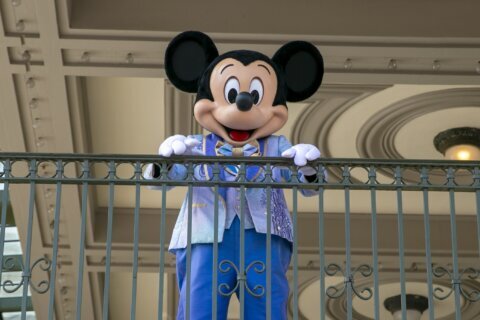WASHINGTON — Call it a seasonal film industry trick, but it’s a treat knowing that each fall, as the wind cools and the leaves change, a thinking-person’s thriller will dare us to outguess its material after a summer of mindless superheroes.
In 2013, it was Denis Villeneuve’s nail-biting “Prisoners.” In 2014, it was David Fincher’s shocking “Gone Girl” (2014). And last year, it was Lenny Abrahamson’s claustrophobic “Room” (2015), which featured just as much suspense as Alex Garland’s sci-fi thriller “Ex Machina” (2015) earlier that year.
Now, get ready for this year’s offering: The much-anticipated “The Girl on the Train,” which like Gillian Flynn’s “Gone Girl,” is based on a best-selling mystery novel in Paula Hawkins’ pulpy page-turner.
Relocating the setting from London to Westchester County, New York, the film follows an alcoholic divorcee named Rachel (Emily Blunt), who rides the train every day past her former suburban home, where her ex-husband Tom (Justin Theroux) lives with his new wife Anna (Rebecca Ferguson) and their baby. Gazing out the window, she becomes obsessed with a seemingly perfect couple next door, Scott (Luke Evans) and Megan (Haley Bennett), only to witness a clue to a mysterious disappearance.
While the plot sounds like “Rear Window” (1954) meets “The Lady Vanishes” (1938), don’t expect the masterful Hitchcock touch just yet. The presentation is far more fragmented, the framing far more gimmicky, the twists far more predictable. Yet despite all this, I still enjoyed the trashy hell out of it.
Much of this is due to Blunt, who’s utterly convincing as the blackout drunk who can’t remember her actions and who’s heartbreaking in her apologies at A.A. meetings. Her slurring, staggering turn is all the more impressive considering she couldn’t drink any actual booze during her real-life pregnancy, sipping faux vodka from a water bottle with mascara dripping around bloodshot eyes via contacts.
Blunt is on fire, crossing genres ranging “The Devil Wears Prada” (2006), “The Young Victoria” (2009), “Salmon Fishing in the Yemen” (2011), “Edge of Tomorrow” (2014), “Into the Woods” (2014) and “Sicario” (2015). With five Golden Globe noms and one win, she is long overdue for an Oscar nod. Could it come for “Girl on the Train” by elevating 2 1/2-star material with a 4-star performance?
At the premiere, Blunt called it the most “ultimately satisfying part” she’s ever played.
Her transformative persona makes Rachel the most compelling of the three “unreliable narrators,” as the film tells its story from the differing perspectives of three troubled suburban women. She’s also the most sympathetic, as Rebecca Ferguson (“Mission Impossible: Rogue Nation”) and Haley Bennett (“The Magnificent Seven”) are transfixing screen presences capable of great work, but are trapped in characters who are given contrived motivations for their over-the-top nympho-maniacal impulses.
It’d be easy to chalk this up as some sort of postfeminist, voyeuristic “male gaze” by director Tate Taylor (“The Help,” “Get On Up”), who loves his close-ups here. But such a theory is too neat for a potboiler written by a woman (author Paula Hawkins), adapted by a woman (screenwriter Erin Cressida Wilson) and photographed by a woman (cinematographer Charlotte Bruus Christensen).
For each sexpot character playing loose with the facts, there are counter examples speaking truth to power, from the by-the-book gumshoe Detective Riley (Allison Janney) to the reliable ex-colleague Martha (Lisa Kudrow). Even among our three troubled narrators, there’s a deceptively profound message hidden beneath the lurid, erotic, surface-level sex mystery: These three women not only have much more in common than they think, but they actually have a lot to learn from each other.
Perhaps this theme would be easier to see if it weren’t lost in the clutter of shifting perspectives. Taylor no doubt does his best to weave the various timelines — introducing each character with title cards — but it never feels as polished as, say, the conflicting accounts of Kurosawa’s “Rashomon” (1950). Particularly confusing here are unnecessary flashbacks to a remote shed in the woods.
Sometimes it’s more effective not to see everything from every angle. The magic of “Rear Window” was that it maintained just one perspective: Jimmy Stewart gazing out of his window. This allowed us to experience the tension along with him, a tension that would have been lost if we jumped across to see Miss Lonelyheart’s P.O.V. looking back or jumped back in time to see the Thorwalds’ arguments.
So while “Girl on the Train” starts as a gripping whodunit barreling down the tracks — painting the town red with red herrings and Danny Elfman’s eerie score — it gradually loses steam with each shift in time and perspective, feeling like flashy overkill compared to the nuance of HBO’s “The Night Of.”
In the end, when the jig is up, we can’t help but feel a little disappointed. Like so many thrillers, the Third Act often becomes the Third Rail when the big reveal doesn’t live up to the juicy onion we’ve been peeling. Here, the climax is too blunt even for Emily Blunt — drawing unwanted giggles from the audience — but her powerful performance keeps the finale on the rails just enough, screeching into the station and leaving us happy we at least took the ride, even if we might not buy another ticket.
For all its flaws, “Girl on the Train” is still a damn good time at the movies. Maybe it’s because this reviewer didn’t read the book, thus found it engaging to solve the whodunit. Or, perhaps yours truly is simply rooting for this genre to succeed. Thrillers too often get a bad wrap by critics who hail their creators in hindsight. Even Hitchcock never won Best Director. Think about that, then recalibrate.
Sure, “The Girl on the Train” is far from a Hitchcockian masterpiece like “Rear Window” (1954) or even a gem like David Fincher’s “Gone Girl” (2014), but it’s at least a solid thriller in a criminally underrated genre. Can you beat a genre that asks us to actively engage with its material to solve a case? Give me that over a mindless summer tentpole any day of the week and twice in October.
This rating is on a four-star scale. See where this film ranks among the year’s best in our Fraley Film Guide.









